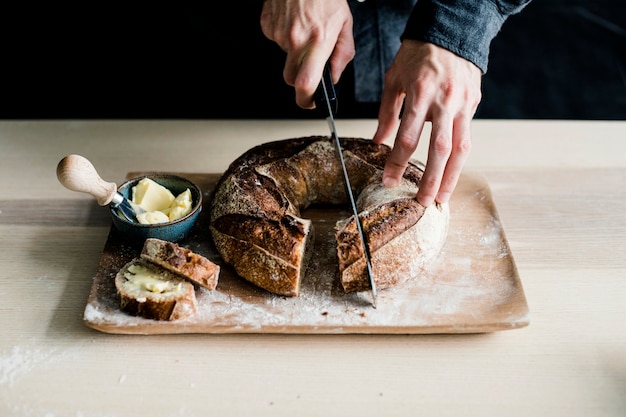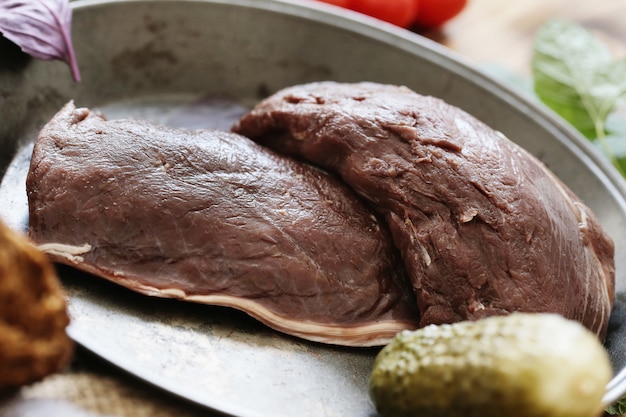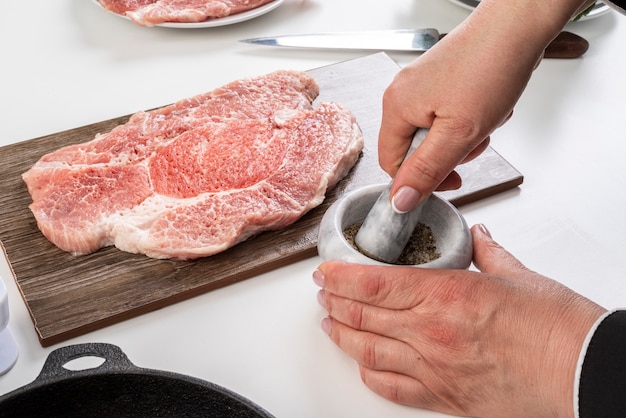Ah, the beef tenderloin. It’s the crown jewel of the meat world, a cut of pure indulgence that whispers of special occasions and celebratory feasts. But let’s be honest, even the most experienced cook can feel a touch of pressure when tackling this elegant piece of meat. Getting it just right – tender, juicy, and cooked to perfection – can feel like a culinary tightrope walk. But don’t worry, my friends! I’m here to guide you through the entire process, sharing my hard-earned tips and tricks for mastering this magnificent cut. So, settle in with a cuppa, and let's embark on this delicious journey together!
Part 1: Choosing the Right Beef Tenderloin

The first step on our culinary adventure is finding the perfect piece of beef tenderloin. Think of it as choosing the right canvas for your masterpiece!
1. Size Matters: Finding the Right Fit
The size of your tenderloin depends entirely on the size of your gathering. A petite piece for two is perfectly delightful, while a larger one for a crowd is essential for sharing the love. I usually aim for a tenderloin weighing in at around 2-3 pounds, which is a fantastic size for a group of 4-6 people. You don’t want to be left with a ton of leftovers (unless that’s your thing, of course!).
2. Fat is Your Friend: Embracing the Marbling
Don’t shy away from the fat! A nice layer of fat running along the outside of the tenderloin is actually your secret weapon. It’s like a built-in moisturizer for the meat, keeping it incredibly juicy and tender during cooking. Look for good marbling throughout the muscle – that's the fat interspersed within the meat, adding layers of flavour.
3. The Colour Code: A Freshness Indicator
A fresh, vibrant red colour is what you’re looking for. It’s the colour of pure, unadulterated beefy goodness! Steer clear of any tenderloin that looks dry, pale, or has any brown or discoloured patches. Trust your eyes, they’re your first line of defence against questionable meat.
4. The Touch Test: Feeling for Quality
Before you take the tenderloin home, give it a gentle squeeze. It should feel firm and springy, like a perfectly ripe peach. If it feels soft or mushy, it might be best to pass on it.
Part 2: Deconstructing the Science of cooking tenderloin

Now that you’ve found the perfect tenderloin, it’s time to delve into the science of cooking it to perfection. Tenderloin is a relatively lean cut of meat, so keeping it juicy and tender requires a bit of finesse and understanding of how it reacts to heat.
1. The Temperature Talk: Reaching the Sweet Spot
The internal temperature is the holy grail of tenderloin cooking. This is where your trusty meat thermometer comes into play. Each level of doneness has a specific internal temperature range:
| Level of Doneness | Internal Temperature (°F) | Internal Temperature (°C) |
|---|---|---|
| Rare | 125-130 | 52-54 |
| Medium Rare | 130-135 | 54-57 |
| Medium | 140-145 | 60-63 |
| Medium Well | 150-155 | 65-68 |
| Well Done | 160 | 71 |
Personally, I’m a big fan of medium-rare. It’s the perfect balance of juicy tenderness and a beautiful pink centre. But hey, to each their own! Ultimately, the key is to cook it to your preference.
2. The Tools of the Trade: A Thermometer and Beyond
A trusty meat thermometer is an absolute must-have for any cook who wants to conquer the tenderloin. It’s your guide to ensuring even cooking and achieving the perfect internal temperature. I’ve found a digital thermometer with a long probe to be the most helpful – it provides fast, accurate readings and makes it a breeze to check the temperature without having to move the meat around too much.
Aside from a thermometer, you’ll also want to have a few other essential tools on hand: a sharp chef’s knife for slicing, a good-quality roasting pan, a cast iron skillet for searing, and of course, a reliable oven or grill.
Part 3: Cooking Methods: Discovering the Possibilities

The beauty of beef tenderloin is its versatility. It can be cooked in a variety of ways, each yielding unique flavours and textures. Let’s dive into some of the most popular methods:
1. The Roast Master: A Classic Approach
Roasting is the time-honoured way to cook tenderloin. It’s simple, reliable, and yields incredibly juicy and flavorful results. Here’s how I like to roast my tenderloin:
- Seasoning: Start by generously seasoning the tenderloin with salt and pepper. For extra flavour, I like to add a touch of garlic powder and onion powder.
- Searing: Preheat your oven to 400°F (200°C) and preheat a cast iron skillet over high heat. Sear the tenderloin for 3-4 minutes per side, creating a beautiful crust.
- Roast It Up: Transfer the tenderloin to a roasting pan. I like to add a few sprigs of rosemary and thyme for added aromatics. Roast the tenderloin for 15-20 minutes, or until the internal temperature reaches your desired level of doneness.
- Rest Time: Let the tenderloin rest for 10-15 minutes before carving. This allows the juices to redistribute throughout the meat, resulting in a more tender and juicy final product.
For a truly exceptional result, try the reverse searing method. This involves cooking the tenderloin at a lower temperature for a longer period, then searing it quickly at the end. The slow cooking ensures even cooking and prevents drying out, while the searing adds that irresistible crispness.
2. Grilling Glory: Embracing the Smoky Flavors
Grilling is the perfect way to add a smoky, rustic flavour to your tenderloin. Here’s how to master the grill:
- Prepping: Preheat your grill to medium-high heat. For a gas grill, make sure the grates are clean. For a charcoal grill, you want the coals to be glowing red and covered in white ash.
- Seasoning: Season the tenderloin generously with salt, pepper, and your favourite spices. I often add garlic powder, paprika, and a pinch of cayenne pepper for a touch of heat.
- Direct Heat: Grill the tenderloin over direct heat for 5-7 minutes per side, or until it’s nicely browned and has a beautiful char.
- Indirect Heat: Move the tenderloin to the indirect heat side of the grill and continue cooking for another 15-20 minutes, or until the internal temperature reaches your desired level of doneness.
- Resting: Remove the tenderloin from the grill and let it rest for 10-15 minutes before slicing.
Remember, clean and hot grates are essential for a perfect sear and prevent sticking. And don’t forget to use your trusty meat thermometer!
3. The Pan-Seared Sensation: A Quick and Easy Option
For those evenings when you need a delicious meal without spending hours in the kitchen, pan-searing is a lifesaver. Here’s how to do it:
- Prepping: Heat a heavy-bottomed pan over medium-high heat. A cast iron skillet is a great choice for this method.
- Searing: Once the pan is smoking hot, add a tablespoon or two of oil and sear the tenderloin for 2-3 minutes per side, creating a beautiful crust.
- Finishing: Reduce the heat to medium-low and continue cooking for another 10-15 minutes, or until the internal temperature reaches your desired level of doneness.
- Resting: Remove the tenderloin from the pan and let it rest for 10-15 minutes before carving.
Using a heavy-bottomed pan ensures even heat distribution. Avoid overcrowding the pan – if you have a large tenderloin, cook it in batches.
4. Sous Vide: The Modern Approach
sous vide cooking is a technique that involves immersing the food in a temperature-controlled water bath. It’s a fantastic method for achieving perfectly cooked, incredibly juicy and tender results every time. Here’s how to sous vide tenderloin:
- Vacuum Seal: Season the tenderloin to your liking and vacuum seal it in a food-safe bag.
- Water Bath: Fill a large pot with water and bring it to the desired temperature for your chosen level of doneness.
- Immersion: Place the vacuum-sealed tenderloin in the water bath and cook for 1-2 hours, or until the internal temperature reaches your desired level of doneness.
- Searing (optional): Once the tenderloin is cooked, you can sear it in a hot pan or grill for a few minutes to give it a crispy crust.
Sous vide is a forgiving method that offers consistent results. It’s perfect for those who prefer a foolproof approach to tenderloin cooking.
Part 4: The Temperature Tango: Mastering the Internal Temperature
I can't stress this enough: the internal temperature is your best friend when it comes to tenderloin. Here's a detailed breakdown of why it matters and how to use it to your advantage:
1. Understanding the Thermometer: Your Culinary Compass
Every serious home cook needs a trusty meat thermometer in their arsenal. It’s the key to achieving the perfect level of doneness and ensuring that the meat is safe to eat. It’s also a great way to avoid overcooking the tenderloin, which can lead to dry, tough meat.
2. The Doneness Chart: A Visual Guide to Perfection
Let's revisit the internal temperatures for different levels of doneness. Here's a handy chart to keep at your fingertips:
| Level of Doneness | Internal Temperature (°F) | Internal Temperature (°C) |
|---|---|---|
| Rare | 125-130 | 52-54 |
| Medium Rare | 130-135 | 54-57 |
| Medium | 140-145 | 60-63 |
| Medium Well | 150-155 | 65-68 |
| Well Done | 160 | 71 |
Remember, these are just guidelines. Ultimately, the choice of doneness is yours.
3. Rest Time is Key: Allowing the Juices to Redistribute
After the tenderloin is cooked, let it rest for 10-15 minutes before carving. This crucial step allows the juices to redistribute throughout the meat, ensuring a more tender and flavorful final product. The meat will also be less likely to release its juices when you slice it.
Part 5: The Saucy Sidekick: Elevating Your Tenderloin
Beef tenderloin is a star on its own, but a delicious sauce can take it to a whole new level of deliciousness. Here are a few sauce ideas to inspire your culinary creativity:
1. Red Wine Sauce: A Classic Choice
Red wine sauce is a classic pairing for beef tenderloin, adding a touch of richness and complexity. To make a red wine sauce, deglaze the pan after searing the tenderloin with a splash of red wine. Add some beef broth, herbs (like rosemary and thyme), and a touch of butter. Simmer until the sauce has thickened and reduced, creating a concentrated flavor.
2. Mushroom Sauce: A Savory Delight
A creamy mushroom sauce is another classic combination that complements the richness of beef tenderloin beautifully. To make this sauce, sauté sliced mushrooms in butter until golden brown. Add a splash of sherry or white wine and simmer until the liquid has reduced. Then, stir in heavy cream and cook until the sauce has thickened, creating a velvety texture.
3. Peppercorn Sauce: A Touch of Spice
For a bit of heat and a peppery kick, a peppercorn sauce is a fantastic choice. Crush some black peppercorns and sauté them in butter until fragrant. Add a splash of red wine or beef broth and simmer until the sauce has thickened.
4. Blue Cheese Sauce: For the Bold Palate
If you’re feeling adventurous, a blue cheese sauce will add a unique and bold flavour to your dish. Melt some butter in a pan and add crumbled blue cheese. Stir until the cheese is melted and smooth, creating a creamy sauce that's both pungent and delicious.
Don't be afraid to experiment with different sauces and flavours. You can even create your own unique sauce combinations based on your personal preferences. Remember, a little bit of sauce goes a long way!
Part 6: side dish Symphony: Completing Your Feast
No feast is complete without a selection of sides that perfectly complement the star of the show. Here are some ideas to create a delicious symphony of flavours and textures:
1. Roasted Vegetables: Earthy and Sweet
Roasted vegetables like Brussels sprouts, carrots, and asparagus are a classic accompaniment to beef tenderloin. They bring a touch of sweetness and earthy flavour to the meal, creating a balanced and satisfying culinary experience.
2. mashed potatoes: Creamy Comfort
creamy mashed potatoes are a classic comfort food that pairs perfectly with the richness of tenderloin. You can keep them simple or add herbs, cheese, or bacon for extra flavour.
3. Risotto: Elegant and Sophisticated
A creamy risotto adds a touch of sophistication and elegance to any meal. It’s a great option for those who are looking for a more refined side dish.
4. Green Salad: A Touch of Lightness
A fresh and vibrant green salad adds a touch of lightness and balance to a rich meal, making it a perfect complement to the tenderloin.
When choosing your side dishes, consider the flavours and textures that will complement your chosen cooking method and sauce. Don’t be afraid to experiment with different combinations to find what you love best!
Part 7: Beef tenderloin recipes: Ready-to-Use Inspiration
To get your culinary juices flowing, here are a few of my favourite beef tenderloin recipes that are guaranteed to impress:
1. Classic Roasted Beef Tenderloin with Red Wine Sauce
This is a timeless classic for a reason. The tenderloin is roasted to perfection and served with a rich and flavourful red wine sauce, creating a truly satisfying dish.
2. grilled beef tenderloin with Herb Butter
This recipe is perfect for summertime grilling. The tenderloin is grilled to perfection and topped with a delicious herb butter, adding a touch of freshness and flavour.
3. pan-seared beef tenderloin with Mushroom Sauce
This recipe is quick and easy to prepare, yet still impressive enough for a special occasion. The tenderloin is pan-seared to perfection and served with a creamy mushroom sauce.
4. Sous Vide Beef Tenderloin with Blue Cheese Sauce
This recipe is for the adventurous cook who loves a bit of bold flavour. The tenderloin is cooked sous vide to perfection and served with a creamy blue cheese sauce.
These recipes are just a starting point. Don’t be afraid to experiment with different flavours, spices, and sauces to create your own unique and delicious beef tenderloin dishes.
Part 8: FAQs: Addressing the Most Common Questions
Here are some frequently asked questions to help you conquer the world of beef tenderloin:
1. How long does it take to cook beef tenderloin?
The cooking time for beef tenderloin depends on the size of the tenderloin and the desired level of doneness. For a 2-3 pound tenderloin, it will take about 15-20 minutes for medium-rare, 20-25 minutes for medium, and 25-30 minutes for medium well. Always use a meat thermometer to ensure it’s cooked to your preference.
2. Can I cook beef tenderloin from frozen?
While it’s not ideal, you can cook beef tenderloin from frozen. However, it will take longer to cook and may not be as tender as if it were cooked from thawed. It’s always best to thaw the tenderloin in the refrigerator overnight before cooking. This allows the meat to thaw slowly and evenly, preserving its texture and flavour.
3. How do I know when beef tenderloin is done?
The best way to tell when beef tenderloin is done is to use a meat thermometer. Insert the thermometer into the thickest part of the meat and check the internal temperature. For medium-rare, the internal temperature should be 130-135°F.
4. How do I slice beef tenderloin?
Once the beef tenderloin is cooked and rested, you can slice it into thin rounds. It’s best to slice the tenderloin against the grain, which means cutting perpendicular to the muscle fibres. This will help make the meat more tender and easier to chew.
5. What can I do with leftover beef tenderloin?
Leftover beef tenderloin is a gift that keeps on giving! It can be used in a variety of dishes, such as salads, sandwiches, or pasta dishes. You can also slice it thinly and serve it cold with horseradish sauce for a delightful appetizer.
I hope this comprehensive guide has armed you with the knowledge and confidence to cook a delicious beef tenderloin that will impress your guests and leave you feeling like a culinary rockstar. Go forth, my friends, and conquer the tenderloin with flair!
Everyone is watching

Prime Rib Roast Cooking Time Chart: Per Pound Guide
Cooking TipsPrime rib roast. Just the name conjures images of lavish dinners, crackling fires, and hearty laughter. It’s ...

How Long to Bake Potatoes in the Oven (Perfect Every Time)
Cooking TipsBaked potatoes are a staple in my kitchen. They're incredibly versatile, delicious, and surprisingly easy to m...

Perfect Rice Every Time: The Ultimate Guide to Cooking Rice
Cooking TipsAs a self-proclaimed foodie, I've always been a bit obsessed with rice. It's the foundation of countless cuisi...

The Ultimate Guide to Cooking Asparagus: Tips, Techniques, and Recipes
Cooking TipsAsparagus. The mere mention of this spring delicacy conjures up images of vibrant green spears, crisp and burs...

Ultimate Guide to Cooking the Perfect Thanksgiving Turkey
Cooking TipsThanksgiving. Just the word conjures up images of overflowing tables laden with delicious food, the scent of r...
